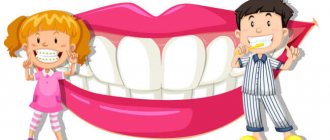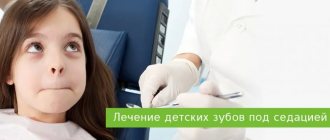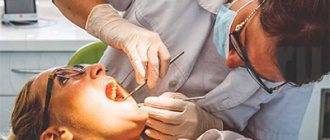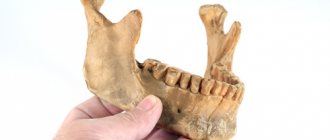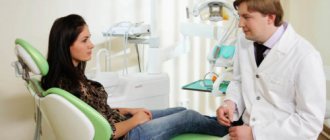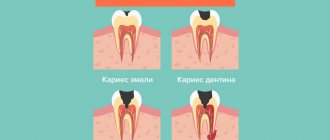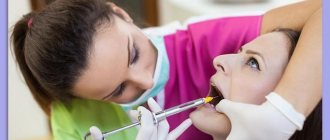The choice of the type of anesthesia for a child is made after a thorough history taking. Dentists should identify possible contraindications to the use of a particular method or pain medication. The risk group includes children with a tendency to allergic reactions.
Most often, topical anesthesia is used as local anesthesia. An anesthetic is applied to the surface of the tissues adjacent to the diseased tooth, which blocks the receptors and terminal sections of nerve fibers in the periphery. Sensitivity is turned off in the surface layers and does not affect the deep ones.
Application anesthesia is also used in other cases:
- if the patient exhibits a pronounced gag reflex during tooth preparation;
- when it is necessary to obtain intraoral X-rays or impressions of the jaw;
- to relieve pain in the marginal periodontium;
- in case of difficult eruption of wisdom teeth - for the period of excision of the hood above them;
- during a biopsy;
- during dissection of the frenulum;
- when performing curettage of periodontal pockets;
- in the treatment of minor destruction of tooth enamel, etc.
Removing wisdom teeth
Anesthesia for wisdom tooth removal is no different from conventional means for treating other teeth. The doctor decides independently how to administer the medicine depending on the specific situation.
Most often, wisdom teeth are removed not because they are affected by caries, but because of their abnormal location. As a result, these teeth have the pathology dystopia or retention.
- Dystopia is the process of eruption of a wisdom tooth that is displaced towards the cheek or tongue.
- Retention is when a wisdom tooth has formed but has not erupted through the gums. In this case, the dentist makes an incision in the gum, removes the wisdom tooth and stitches the incision. Typically, such surgical procedures are performed under local anesthesia.
How is topical anesthesia performed?
The area of the mucous membrane is dried with a cotton swab. Then a small amount of anesthetic is carefully applied to it with a cotton swab or swab. The drug instantly penetrates 2-3 mm deep - the effect occurs within 30-40 seconds in the case of solutions and after 2 minutes if ointments or gel are used. The anesthesia lasts for 10-15 minutes.
As anesthetic agents in pediatric dentistry, those that meet certain requirements are used:
- soluble in water and isotonic solution;
- demonstrate high resistance to sterilization and stability in solutions;
- have a bactericidal effect and a pleasant taste, which is important for children;
- penetrate well through the epithelial layer;
- provide rapid pain relief;
- do not cause irritation;
- exhibit minimal toxicity upon absorption;
- give a minimum of adverse reactions.
Drugs used
Anesthesia in dentistry requires the use of fast-acting anesthetics. It is important to achieve “freezing” of tissues to a certain depth and for a specific period of time.
Preparations for pain relief in dentistry:
- Mepivazestine - characterized by rapid loss of sensitivity, can be used in pediatric dentistry (from 4 years and older);
- Septanest is an affordable anesthetic that can cause allergic reactions due to the presence of sodium sulfate in the composition;
- Ultracaine is the most common drug for anesthesia in dentistry; it is highly effective and has different dosages;
- Scandonest is a modern generation anesthetic that has a low risk of allergic reactions and other complications;
- Bizestin is an analogue of the frequently used drug Ultracain, and has a lower cost in comparison with it.
What drugs are used for topical anesthesia?
In pediatric dentistry, solutions, emulsions, ointments, pastes, gels, aerosols are used, as well as special dispersed tablets, caramels and children's chewing gum. They contain highly concentrated anesthetics without vasoconstrictors. Most often, dentists use solutions, sprays and aerosols.
- "Babident" is intended for pain relief during the eruption of primary teeth in infants. Apply 1-2 drops of the solution with a cotton swab or finger to the mucous membrane of the gums 1-3 times a day.
- In pediatric dentistry, Perylene-Ultra solution is often used.
- The most popular gels and pastes are “Xylonor”, “Instilagel”, “Aroma paste carried”, Jen-Dental, Xyligel.
- The most commonly used ointments are 2-3% dicaine, 5% lidocaine, 2-3% falicaine, etc.
Local anesthesia
Local anesthesia is used more often in dentistry. Unlike general anesthesia, it does not have a negative effect on the general condition of a person and is not accompanied by loss of consciousness and a recovery period.
In dentistry, the injection method of local sedation is predominantly used. It involves loss of sensitivity locally, in the area of the oral cavity that the dentist plans to work with. The technique of local anesthesia can be direct or indirect. The first option is used primarily in the treatment of dental canals and gums, when a specialist injects an anesthetic at once, and the second option is used when removing teeth (layer-by-layer distribution of the anesthetic). Indirect anesthesia can significantly increase the area of sensory loss.
Spray irrigation method
According to the results of clinical studies, the most pronounced analgesic effect in the treatment of caries of temporary teeth is provided by sprays and aerosols, for example Lignospam, Lidokain 10%, Legekain, etc. Anesthesia occurs after 30-40 seconds and lasts for 15 minutes. Due to their unpleasant taste, gels and aerosols are contraindicated in children under four years of age, as they increase salivation and can enter the respiratory tract and cause respiratory arrest.
Older children also complain of local symptoms after irrigation - numbness of the laryngeal tissue, sensation of a lump in the throat, hoarseness, which sometimes lead to breathing problems. Therefore, before using sprays and aerosols, the dentist must tell the patient how to behave correctly and make sure that he has accepted the information. This type of anesthesia can only be done while exhaling, but it is safer to apply the product to a cotton swab and apply it to the area, similar to liquid solutions.
Features of tooth extraction in pregnant women
Tooth extraction is considered a major surgical procedure. If such an operation is necessary, only high-quality drugs should be used for pain relief. Tooth extraction in pregnant women is carried out only for serious indications, when other treatment methods do not give the desired result.
Removing wisdom teeth has its own characteristics. This operation is more complex and difficult for the body to tolerate. Very often, to prevent wound infection, the patient is prescribed antibiotics, which is unacceptable during pregnancy.
Anesthesia
Anesthesia is a general anesthesia in which a person is put into a medicated sleep. At the same time, his consciousness is completely turned off. General anesthesia is carried out by inhalation, injection or a combination method.
The entire time the patient is under anesthesia, he is monitored by an anesthesiologist. He checks the pulse, blood pressure, breathing rate, the general condition of the body and its reaction to what is happening.
Before using general anesthesia, it is necessary to diagnose the condition of the body and undergo a series of tests. On the day of the procedure, you should not eat, drink or smoke.
Do not forget that anesthesia is an effect on the body with the help of narcotic drugs. It is impossible to predict the reaction in advance. Therefore, it is highly undesirable to resort to anesthesia when treating teeth.
Types of local anesthesia
There are several types of local anesthesia, it all depends on where exactly the drug is injected, what properties it has and how long it lasts.
The simplest and most frequently used method is application, otherwise freezing:
- For application, gels, sprays and other local products are used. The effect of them is short-lived, everything is safe for the body.
- The infiltration method is a type of local anesthesia and is often used. Most often used to treat teeth in the upper row. An anesthetic is injected into the apex of the tooth root using an injection. Used to treat one tooth.
- To anesthetize several teeth at once, the conduction method is used. This method is also used for tooth extraction, as well as for the treatment of purulent lesions. The entire nerve branch is anesthetized.
- The stem method is the most powerful method of anesthesia. An injection with the drug is placed at the base of the skull. Used for major surgery. Allowed for use in hospital settings.
The drug is injected into the lower jaw as deeply as possible
The attending physician decides which method to choose.
Freezing duration
How long does it take for a tooth to freeze after treatment? This question interests many patients. Application anesthesia does not last long - no more than five minutes. This time is enough for the doctor to perform all the necessary manipulations.
As for injection anesthesia, the duration of its effect depends on which jaw was injected. So, for example, if the dosage was the same, then on the upper jaw the effect lasts up to three hours, on the lower jaw – at least four.
For some it lasts a little less or a little longer, it all depends on the individual characteristics of the patient. If the freezing does not go away for a long time after dental treatment, you should seek help from your doctor.
What determines the duration of anesthesia?
Inflamed gums can cause the anesthesia to take a long time to wear off.
How quickly does the anesthesia wear off?
It all depends on a number of factors, you can consider them below:
- The presence of vasoconstrictors in the composition of the drug. Under the influence of the components, the vessels narrow, the speed of action becomes lower - the effect as a result of this is long-lasting, and therefore it takes much longer to recover.
- The presence of an inflammatory process in the area where the injection was given. There is a collision between the oxygen environment in the inflammatory process and the alkaline environment of the drug. The effect of the drug is completely or partially neutralized.
- Patient's age. Adults respond poorly to the drug and recover from it very slowly.
- The presence of chronic gastrointestinal diseases. How well the kidneys and liver work determines how long it will take for the remaining drug to be eliminated. If there are diseases of these organs, the painkiller will take a long time to act.
- Was the procedure carried out correctly? Achieving the desired result primarily depends on whether all actions were performed correctly by the specialist.
- The type of medicine used.
Thus, we can conclude that many factors influence how long the anesthesia will take to wear off.
Consequences after using anesthesia
Your throat may hurt after the procedure
Only the dentist decides what kind of anesthesia to use. Age, the possibility of developing allergies and other points are taken into account.
However, there are side effects that many people may experience:
- weakening of the general condition;
- feeling of pain in the mouth and throat;
- discomfort in the stomach;
- aching bones;
- itching and redness of the skin.
The most dangerous and serious complication is infection of the lungs, necrosis of the tissues of the lips and teeth.
If the dosage of the medicine was chosen incorrectly and it was administered incorrectly, the following symptoms may bother you:
- minor damage to the nerve process occurs;
- nerve cells die;
- anaphylactic shock or minor allergic reactions.
The most dangerous thing that can happen is anaphylactic shock
It is extremely rare that the brain is affected, resulting in the patient dying. The list of complications is actually long, which means that you need to be extremely careful with pain relief.
Sedation
Fear. This is the feeling that most people have when they think about visiting the dentist's office. Under a feeling of fear, movements become constrained, and especially impressionable people may even lose consciousness during or immediately before the procedure.
For emotional and physical relaxation, sedation is used in dentistry. Through a special mask, the patient inhales an oxygen-nitrogen mixture. Thanks to this, a feeling of calm appears. This procedure is in demand in pediatric dentistry, since it is usually difficult to calm a small child before the procedure.
If the patient has respiratory diseases or sensitivity to the components of the gas mixture, sedation is given intravenously. But this method is used extremely rarely.
Sedation in no way replaces anesthesia. It is used as an adjunct to calm and relax the patient. At the same time, he remains conscious throughout the session, and the effect of the gas wears off as soon as the mask is removed.
However, it is worth noting that despite all the seemingly positive effects of sedation, it is better to do without it. A clear mind and fresh consciousness allow you to quickly respond if necessary if something goes wrong.
Useful tips
When planning a pregnancy, it is very important to solve, if possible, all health problems, especially dental ones. A developing child takes all the necessary microelements from the mother's body. If a woman does not have enough calcium, then, first of all, her teeth will suffer. Cavities or even tooth loss may begin. Therefore, expectant mothers need to regularly visit the dentist for preventive examinations.
It is recommended to pay special attention to your diet and oral care. Proper hygiene will help prevent tooth decay. You should brush your teeth twice a day, and also use dental floss and a mild mouth rinse. Professional teeth cleaning and removal of dental plaque should be postponed until after childbirth.
When diagnosing some diseases, an X-ray examination of the patient is used. This method is undesirable for pregnant women, as the radiation can negatively affect the development of the fetus. In case of emergency, diagnostics are carried out using a special protective apron.
Severe toothache may indicate the presence of a serious inflammatory process in the oral cavity.
The bacteria that cause the infection can spread throughout the body and cause serious illness. Therefore, you should consult a dentist as soon as possible and treat the inflammation. Moscow metro station Zvezdnaya, Danube Avenue, 23
What should I do to make the anesthesia wear off?
The anesthesia will go away faster if you do a massage.
In order to avoid undesirable consequences, you should ask your doctor in advance how to remove the frost after dental treatment.
The specialist should explain that in order for the painkiller to wear off as quickly as possible, you need to follow a few simple rules:
- A few hours before visiting the dentist, it is not recommended to eat heavy food or drink alcohol. Do not take any medicines unless they have been prescribed to you by your doctor.
- In order for the frost to go away faster after a simple dental procedure, it is recommended to drink something warm, as well as massage the numb area.
- After a serious intervention (pulp opening, drainage, etc.), you should not drink or touch this area. Stop drinking for an hour after the intervention, and do not eat food for four to five hours.
After dental treatment, you should not drink for several hours.
If the effect of the painkiller does not go away for a long time, then you need to visit a doctor as soon as possible. It is possible that a nerve was damaged during the intervention. In this case, physical therapy is performed, and a consultation with a neurologist may be required.
Anesthesia in pregnant and lactating women
During pregnancy, dentists do not recommend dental treatment; if possible, this should be postponed until later. However, there are situations in life when it is impossible to tolerate. The most successful period for such manipulations is the second trimester.
But what kind of pain relief should be used during this period? The composition should not contain adrenaline; the patient’s blood pressure should not be allowed to increase, otherwise the uterus will begin to contract.
Dental treatment for pregnant women is not recommended
Important! The drug must be non-toxic; if necessary, the procedure is carried out in a hospital.
There is no danger during lactation, and the doctor can safely use an anesthetic. This anesthesia acts locally, does not penetrate into the blood, and has no toxic effect on the body.
In order to still protect your child, you need to feed him before going to the dentist, and also express milk for the next feeding.
Freezing usually does not last longer than a few hours. If everything was done correctly and the doctor did not make a mistake, then the procedure goes well and the patient does not feel any discomfort.

